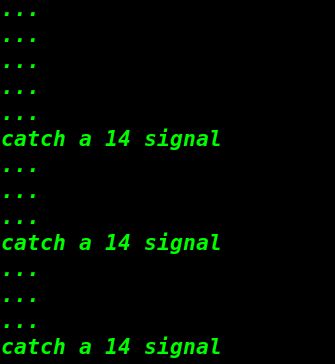Linux进程(下)
一. 信号
Ⅰ. 信号的基本概念
信号
信号产生
- 按键产生,
Ctrl + c、Ctrl + z; - 调用函数,
kill、raise、abort; - 定时器,
alarm、setitimer; - 命令产生,
kill; - 硬件异常,段错误,浮点型错误,总线错误,SIGPIPE。
linux 查看信号种类man 7 signal
Ⅱ. kill 函数
man 2 kill
#include - pid > 0, 要发送进程 ID;
- pid = 0,代表当前调用进程组内所有进程;
- pid = -1,代表有权限发送的所有进程;
- pid < 0,代表-pid 对应的组内所有进程;
- sig 对应信号 。
简单使用,用子进程结束父进程。
#include Ⅲ. raise 函数
给自己发信号。
man raise
#include #include Ⅳ. alarm 函数
定时给自己发送 SIGALRM。
man 2 alarm
#include - 参数秒,表示几秒后给自己发送信号
- 返回值,闹钟剩余秒数
#include 程序运行可以看到,的确在第六秒发送了信号。
Ⅴ. 捕获信号函数
当有信号的时候调用函数。
man 2 signal
#include man 2 sigaction
#include - 参数
- signum,传入的信号
- act,传入的动作
- oldact,原动作
sigaction 结构体
struct sigaction {
void (*sa_handler)(int);
void (*sa_sigaction)(int, siginfo_t *, void *);
sigset_t sa_mask; // 临时屏蔽的信号集
int sa_flags; // 0使用第一个函数指针, SA_SIGINFO使用第二个函数指针
void (*sa_restorer)(void); // 无效
};
Ⅵ. setitimer 函数
周期性的发送信号。
man 2 setitimer
#include - 参数
- which
- ITIMER_REAL,自然定时,信号 SIGALRM ;
- TIMER_VIRTUAL,进程执行时间,信号 SIGVTALRM;
- ITIMER_PROF,进程执行时间+CPU 调度时间,信号 SIGPROF。
- new_value
- 传入参数,要设置的闹钟时间。
- old_value
- 传出参数,得到原来的闹钟时间。
- which
struct itimerval 结构体定义
struct itimerval {
struct timeval it_interval; /* Interval for periodic timer 周期性时间设置*/
struct timeval it_value; /* Time until next expiration 下次闹钟产生*/
};
struct timeval 结构体定义
struct timeval {
time_t tv_sec; /* seconds */
suseconds_t tv_usec; /* microseconds 微秒*/
};
使用:
#include 通过运行结果,我们可以看到,程序的确是按照我们的预期跑的,5 秒后闹钟产生,之后每隔 3 秒发送一次信号。
Ⅶ. 信号集函数
man 3 sigemptyset
#include sigismember()返回 1 表示 signum 在集合中,0 表示不在,-1 失败,设置 error。
其余返回 0 表示成功,-1 表示失败,设置 error。
设置阻塞或解除阻塞信号集。
man 3 sigprocmask
#include - 参数
- how
- SIG_BLOCK 设置阻塞;
- SIG_UNBLOCK 解除阻塞;
- SIG_SETMASK 设置 set 为新的阻塞信号集。
- set 传入的信号集
- oset 传出参数,旧的信号集
- how
- 返回 0 表示成功,-1 失败,设置 error。
获取未决信号集。
man 3 sigpending
#include 利用 SIGCHLD 回收子进程
#include 通过ps -ajx可以看到,的确杀死了子进程。
二. 守护进程
个人理解守护进程,不用占用终端,程序可以一直进行下去 ,守护进程一般以 d 结尾,linux 下有 systemd 系统工具来启动守护进程。
创建守护进程步骤:
- 创建子进程,kill 父进程;
- 子进程调用 setsid 当会话组长和进程组长,失去终端;
- 忽略 SIGHUP 信号;
- 切换工作目录;
- 用 umask 设置掩码;
- 关闭文件描述符 0、1、2,避免资源浪费;
- 执行核心逻辑;
- 守护进程退出,通过
kill pid。
创建守护进程:
#include 可以看到,守护进程创建成功。
三. 总结
本来还打算用信号和线程写一个睡眠排序,发现好像有点困难,就放弃了。
linux 下的进程就算粗略学习完了,绝知此事要躬行,还有很多要学习的。



